For shady boundaries, you’ll find excellent fast-growing options in climbing hydrangea, shade-tolerant roses like ‘Wedding Day’, and elegant ferns that reach up to 5 feet tall. Consider clumping bamboo varieties such as Fargesia for height, Japanese Forest Grass for texture, and evergreen shrubs like yew and holly for structure. Serviceberry and elderberry provide wildlife-friendly barriers, while climbing vines create dynamic vertical interest. These versatile plants transform challenging shade spots into lush, private garden boundaries.
Climbing Hydrangea: Elegant Foliage for North-Facing Boundaries
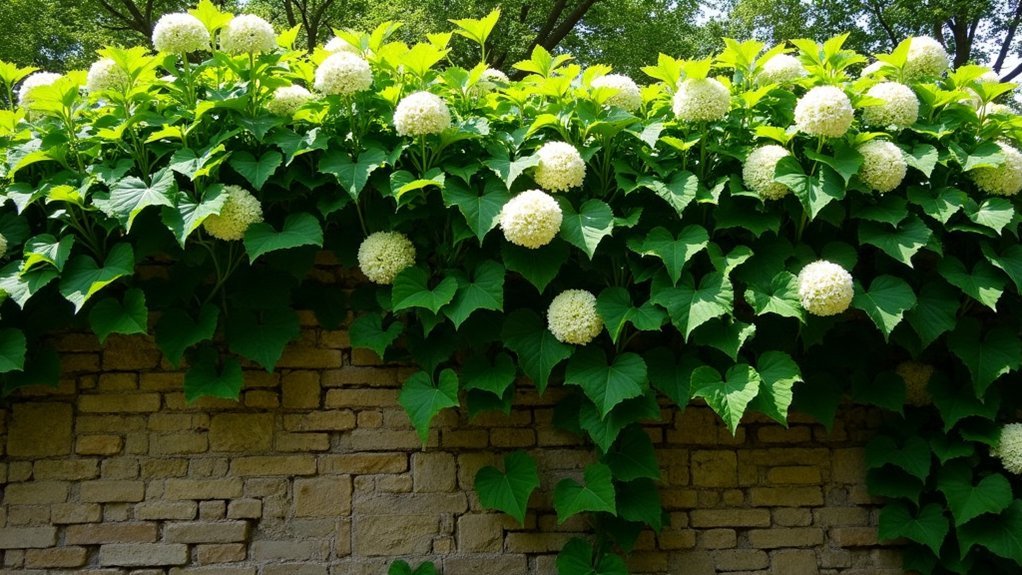
When you’re faced with a shadowy northern boundary that seems impossible to beautify, climbing hydrangea emerges as a remarkable solution. This vigorous deciduous climber can reach impressive heights of up to 50 feet, transforming bare walls into verdant displays.
Thriving in partial to full shade, Hydrangea anomala petiolaris is perfectly adapted for those challenging low-light areas in your shade garden. Its spectacular lacecap flower clusters appear in late spring, bringing elegant visual interest to otherwise plain boundaries.
You’ll appreciate how this low-maintenance climber attaches itself to structures with aerial roots, eliminating the need for trellises or support systems.
Hardy in zones 4-8 and adaptable to various soil types (provided they’re well-drained), climbing hydrangea offers a resilient and sophisticated option for your shadiest garden spaces.
Fast-Growing Ferns: Natural Privacy Screens for Deep Shade
You’ll find several dramatic fern varieties reaching up to 2 feet tall that create effective natural screens in deep shade conditions.
These resilient plants offer year-round privacy with evergreen options like the Autumn Fern maintaining their lush appearance throughout seasons when other plants go dormant.
Ferns require minimal maintenance once established, needing only occasional watering during dry spells and annual removal of dead fronds to keep their screening potential at its peak.
Dramatic Height Options
Why settle for sparse coverage when ferns can transform your shady boundaries into lush, vertical privacy screens? For dramatic height in moist, full shade areas, consider the majestic Ostrich fern, which soars to 4 feet tall with its feathery, architectural fronds. The Royal fern thrives in rich soil conditions, reaching impressive heights of 3-5 feet to create substantial natural barriers.
| Fern Variety | Height | Ideal Conditions |
|---|---|---|
| Ostrich Fern | 4 ft | Moist, full shade |
| Royal Fern | 3-5 ft | Rich, damp soil |
| Sensitive Fern | 2-3 ft | Wet, shaded areas |
These fast-growing ferns don’t just provide privacy—they add architectural interest to your landscape. Even in challenging low-light conditions, they’ll quickly establish themselves, creating dramatic vertical elements that transform ordinary boundaries into striking garden features.
Year-Round Screening Potential
Unlike deciduous shrubs that leave gaps during winter months, many fast-growing ferns offer exceptional year-round screening in even the deepest shade conditions.
The Autumn Fern thrives where other plants fail, creating lush, natural barriers with minimal maintenance.
You’ll appreciate how evergreen varieties maintain privacy throughout all seasons, particularly in challenging ground areas beneath trees.
Maidenhair Ferns can reach impressive 3-foot heights, adding delicate texture while effectively blocking unwanted views.
For reliable coverage in deep shade, consider Ostrich Ferns, which spread rapidly through rhizomes to establish dense screens.
While not typically drought tolerant, most ferns thrive with consistent moisture in rich, well-drained soil.
Their ability to flourish in woodland settings makes them perfect solutions for shaded boundaries where privacy is desired year-round.
Minimal Maintenance Requirements
Once established, fast-growing ferns demand surprisingly little attention compared to other boundary plants, making them perfect low-maintenance options for shaded areas.
These shade plants thrive with consistent moisture and rich, well-drained soil, requiring only occasional watering during dry spells.
You’ll appreciate that ferns like the Autumn, Lady, and Ostrich varieties naturally maintain their attractive appearance throughout the growing season without extensive pruning.
Their natural spreading habit creates dense, elegant foliage that effectively blocks unwanted views while enhancing your landscape’s aesthetic.
- Only light feeding once in spring supports robust growth all season
- Hardy varieties (zones 3-8) adapt to various climates with minimal protection
- Natural growth patterns eliminate the need for constant shaping or training
These minimal maintenance characteristics make fast-growing ferns ideal for busy gardeners seeking effortless privacy solutions.
Bamboo Varieties That Thrive Without Direct Sunlight
When selecting bamboo for shaded boundaries, you’ll want to focus on non-invasive clumping varieties like Fargesia murielae and Fargesia nitida rather than invasive running types.
These clumping bamboos form tight, well-behaved clusters that won’t take over your garden, unlike their running counterparts that send out underground rhizomes and can quickly become unmanageable.
Fargesia bamboos offer the perfect combination of privacy, shade tolerance, and containment, reaching impressive heights of 6-12 feet even in partial to full shade conditions.
Non-Invasive Shade Bamboo
For gardeners seeking privacy solutions in shaded boundaries, non-invasive bamboo varieties offer an elegant and practical choice. Fargesia species like F. murielae and F. nitida thrive where sunlight is limited, growing up to 10 feet tall while maintaining their clump-forming habit.
Unlike aggressive running bamboos, these shade-tolerant options won’t take over your garden.
You’ll appreciate how these fast-growing plants can establish quickly, adding up to 3 feet annually. They prefer well-drained, rich soil and consistent moisture to flourish in their shaded environment.
- Create natural sound barriers perfect for urban settings
- Establish year-round privacy screens without invasive spreading
- Enjoy elegant, arching foliage that adds texture and movement to shaded corners
Plant these non-invasive bamboos confidently in smaller gardens, knowing they’ll provide the perfect balance of privacy and containment.
Clumping vs. Running
Understanding the difference between clumping and running bamboo varieties is essential when designing a shady boundary. Clumping bamboo, like Fargesia murielae, is your ideal choice for shade-tolerant privacy screens. These well-behaved plants grow in tight clusters, reaching 10-15 feet tall while remaining manageable in your garden.
In contrast, running bamboo varieties such as Phyllostachys aureosulcata can also tolerate partial shade but require vigilant control to prevent aggressive spreading. They’ll quickly establish themselves but demand more maintenance.
For best results with either type, plant in well-drained, rich soil. Remember that bamboo grows more slowly in shade, typically taking 3-5 years to reach full height.
Consider your hardiness zone when selecting—Fargesia thrives in Zones 5-9, while running types often prefer Zones 6-10.
Evergreen Shrubs for Year-Round Shady Border Definition
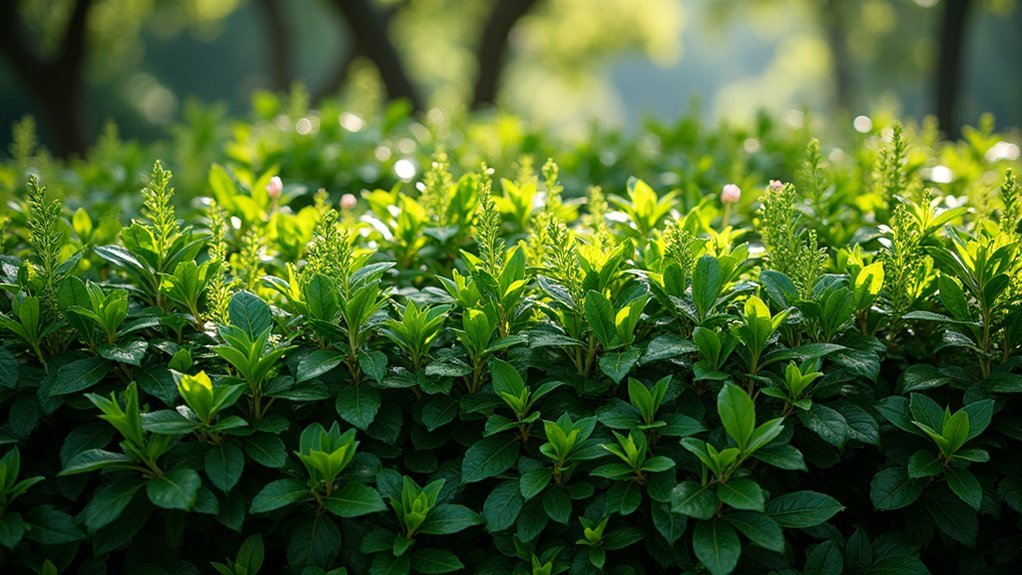
Though often overlooked, evergreen shrubs provide essential structure and definition to shady boundaries throughout all seasons. Japanese Yew and Boxwood thrive in partial shade, delivering dense foliage that creates effective privacy screens while requiring minimal sunlight.
Evergreen shrubs stand as silent sentinels, defining shaded spaces with year-round structure where other plants retreat.
Holly varieties offer dual benefits—they’ll flourish in shaded areas while producing vibrant red berries that bring winter color to your landscape. For rapid coverage, consider Laurel with its glossy leaves and impressive growth potential of 10-15 feet when left unpruned.
- These hardy plants create wildlife habitats, supporting local biodiversity in your garden ecosystem.
- Their year-round presence guarantees your boundary remains defined even during dormant seasons.
- Most evergreen shrubs for shady boundaries require less maintenance than their deciduous counterparts.
Climbing Roses for Partially Shaded Boundary Walls
While climbing roses like ‘Wedding Day’ can flourish in partial shade with as little as 3-4 hours of daily sunlight, you’ll need to position them where they receive morning sun for ideal flowering.
You’ll find varieties such as ‘New Dawn’, ‘Zéphirine Drouhin’, and ‘Albéric Barbier’ particularly adaptable to north-facing walls, requiring minimal intervention once established.
Prune your shade-tolerant climbers during late winter, removing dead wood and tying in new canes horizontally to encourage more flowering points along the boundary.
Light Requirements Analysis
Despite their reputation as sun-loving plants, certain climbing roses, especially ‘Wedding Day’, can flourish in partially shaded boundary areas where many other flowering plants struggle.
You’ll find that these adaptable roses balance their need for sun with surprising shade tolerance, maintaining lush green foliage even when direct sunlight is limited to just a few hours daily.
When selecting climbing roses for your boundary walls, consider:
- Morning sun with afternoon shade offers ideal conditions for ‘Wedding Day’ roses, promoting healthy growth while protecting blooms from harsh midday heat
- Dappled shade environments allow sufficient light filtration while providing necessary protection
- Northern-facing boundaries with 3-4 hours of indirect sunlight can still support these versatile climbers
The key is understanding that partial shade doesn’t mean darkness—it’s about finding that sweet spot where your climbing roses receive adequate light while enjoying protection.
Top Shade-Tolerant Varieties
The remarkable ‘Wedding Day’ rose leads our selection of shade-tolerant climbers, offering prolific growth even in challenging light conditions. This climbing rose thrives in partial shade and tolerates poor soil, making it perfect for north-facing boundaries.
| Plant | Key Features | Light Needs | Soil Requirements |
|---|---|---|---|
| Rosa Wedding Day | Fragrant, fast-growing | Partial shade | Moist, well-drained |
| Lonicera Serotina | Wildlife-friendly, scented | Partial shade | Adaptable |
| Clematis viticella Black Prince | Indigo blooms, tough | Partial shade | Well-drained |
| Clematis alpina Helsingborg | No pruning needed, cascading | Shade | Adaptable |
For your shaded garden, these varieties deliver both coverage and visual interest without requiring full sun exposure—ideal solutions when transforming challenging boundary areas into lush, vertical gardens.
Pruning For Success
Successful cultivation of climbing roses along shaded boundaries depends primarily on proper pruning techniques. When growing varieties like Rosa Wedding Day in partially shaded areas, you’ll need to prune strategically to maximize flowering and coverage.
Schedule your pruning in late winter or early spring before new growth appears, focusing on removing dead or weak stems while cutting back vigorous growth to maintain shape.
- Support your climbing roses on trellises or fences to improve sunlight exposure and make pruning more accessible.
- Apply a balanced organic fertilizer immediately after pruning to fuel the plant’s rapid growth phase.
- Create better air circulation through selective thinning, which prevents disease issues common in shaded areas.
After pruning, your climbing roses will quickly transform boundary walls into lush, fragrant screens even with limited sunlight.
Japanese Maples: Architectural Elements for Woodland Edges
Elegance personified, Japanese maples offer a sophisticated solution for gardeners seeking to enhance shaded boundaries with structural beauty.
These ornamental trees thrive in partial shade, making them perfect additions to shaded woodland edges where their delicate, lobed foliage creates stunning textural contrast against coarser plants.
While not the fastest growers—developing at a slow to moderate pace—their eventual 10 to 25-foot height provides lasting architectural impact worth the wait.
You’ll find these beauties adaptable to USDA zones 5-8, where they’ll reward you with spectacular seasonal color ranging from deep reds to vibrant greens.
Plant your Japanese maple in well-drained, fertile soil along garden boundaries to create a focal point that softens transitions between spaces while adding year-round visual interest to your shaded landscape.
Shade-Tolerant Vines That Won’t Damage Existing Structures
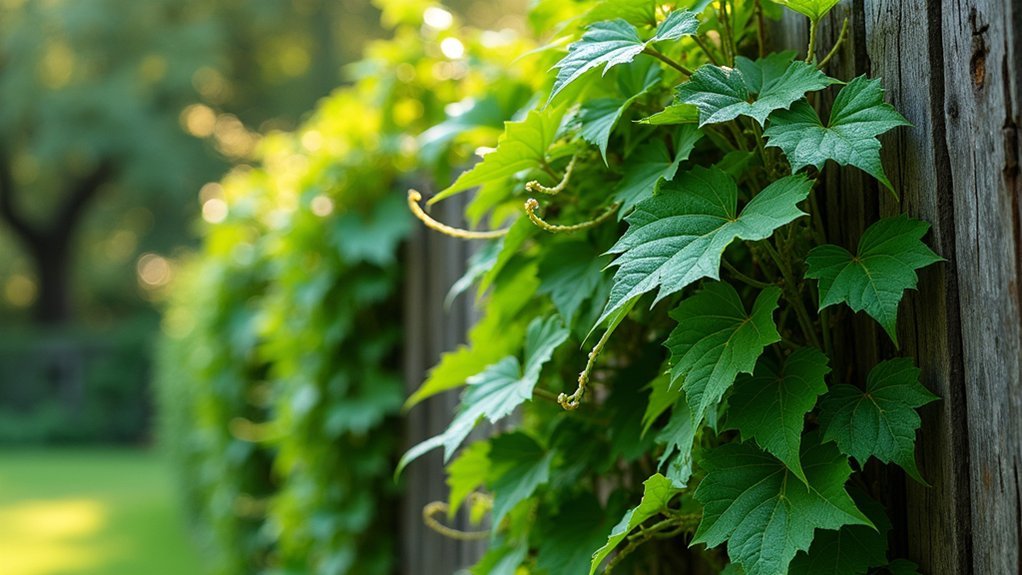
Climbing beauties offer elegant solutions for shady boundaries where you’re concerned about structural integrity.
Clematis varieties like Black Prince and alpina Helsingborg thrive in partial shade, with the former producing rich indigo blooms and the latter requiring minimal pruning.
Honeysuckle Serotina delivers fragrant flowers while safely twining around your structures, attracting wildlife to your garden space.
For deeper shade conditions, consider Hedera helix Halebob or Boston ivy, both capable of quickly covering unsightly boundaries without compromising their stability.
- Choose clematis for spectacular summer blooms that transform dull boundaries into vertical gardens
- Opt for honeysuckle when you’re looking to combine beauty with biodiversity benefits
- Select ivy varieties for year-round coverage when climbing over fences in heavily shaded locations
Berry-Producing Shrubs for Wildlife-Friendly Shade Boundaries
Creating a wildlife sanctuary along your shaded boundaries becomes remarkably simple when you incorporate berry-producing shrubs that thrive in low light conditions.
Serviceberry offers stunning spring blooms and fall foliage alongside its wildlife-attracting fruits.
Serviceberry stands as nature’s calendar—spring’s white flowers, summer’s purple fruits, and autumn’s fiery display mark the seasons in your shade garden.
Black chokeberry flourishes in partial shade while providing drought resistance and abundant berries that birds love.
If you’ve got moist areas, elderberry grows quickly to 12 feet tall, supporting both birds and beneficial insects.
Don’t overlook highbush cranberry, which produces bright red berries useful for both wildlife and your kitchen.
For a double benefit, plant raspberries in partial shade—they’ll create a wildlife-friendly boundary while supplying sweet treats for your table.
These versatile shrubs transform ordinary boundaries into vibrant ecosystems that support local biodiversity.
Ornamental Grasses That Excel in Low-Light Conditions
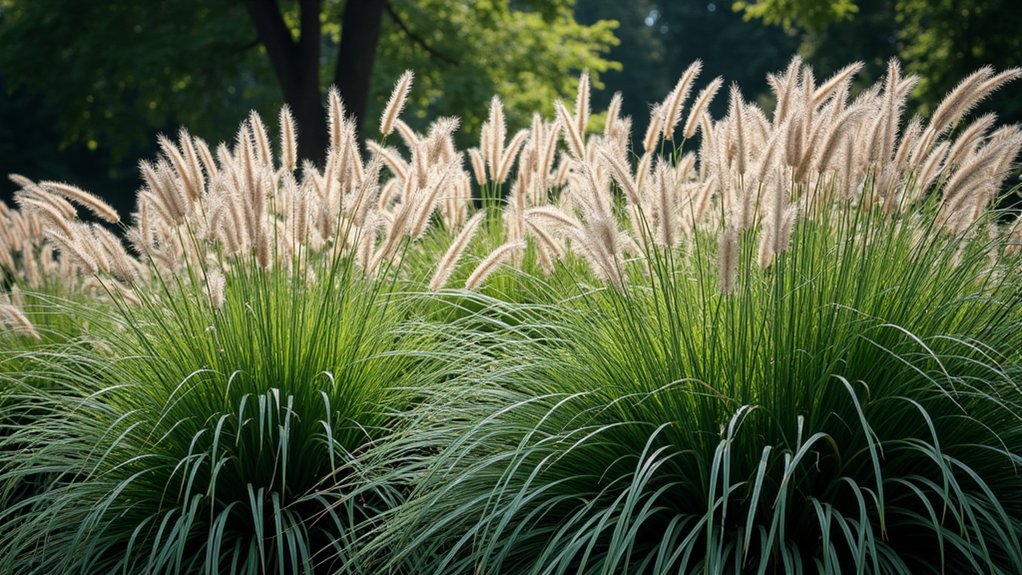
While berry-producing shrubs add biodiversity to shaded areas, ornamental grasses offer a different yet equally valuable dimension to your boundary plantings.
Shade-tolerant varieties like Japanese Forest Grass create elegant, arching textures in low-light environments, while Northern Sea Oats provide height (up to 3 feet) and distinctive seed heads that dance in the slightest breeze.
For shady boundaries with varying moisture levels, consider these versatile options:
- Sedge varieties (Carex elata) thrive in wetter conditions, forming lush clumps 1-2 feet tall
- Blue Fescue adapts to partial shade, offering striking blue-gray foliage as a color contrast
- Foxtail Fern, though not a true grass, provides similar texture with its feathery appearance in indirect light
These ornamental grasses require minimal maintenance while providing year-round structural interest.
Mixed Hedge Solutions for Challenging Light Transitions
As gardens shift from sunny spots to deeply shaded areas, finding plants that can adapt to these gradient conditions presents a unique challenge for boundary design.
Creating mixed hedges with fast-growing plants like Clematis viticella and fragrant Honeysuckle offers an elegant solution, particularly where light varies throughout the day.
Graceful Clematis and aromatic Honeysuckle create dynamic hedges that embrace shifting daylight patterns with natural elegance.
For deeper shade zones, incorporate variegated Ivy varieties that excel at covering structures while brightening dark corners.
Shade-tolerant perennials such as Hostas introduce fascinating texture with their distinctive foliage, creating visual interest at lower levels of your hedge.
Don’t overlook Autumn Fern and colorful Coleus varieties for challenging changes—they’ll not only thrive in difficult light conditions but also support local wildlife.
These combinations provide year-round structure while handling the complex light patterns many garden boundaries experience.
Frequently Asked Questions
What Is the Fastest Growing Plant in Shade?
Japanese Spurge (Pachysandra terminalis) is the fastest growing shade plant. You’ll notice it spreads quickly, establishing dense ground cover in just one growing season. It’s perfect for areas with limited sunlight.
What Plants Thrive in Shady Areas?
In shady areas, you’ll find Hostas, Caladiums, Woodland Phlox, Autumn Ferns, and Impatiens thrive wonderfully. They’re all adapted to low light conditions and will flourish where other plants can’t grow well.
What Is the Fastest Growing Shade Ground Cover?
For the fastest growing shade ground cover, you’ll love Impatiens or Trifoliate Bittercress. They’ll quickly spread in shady spots, with Impatiens offering vibrant flowers and Bittercress reaching full coverage impressively fast.
What Is the Best Plant to Block Neighbors’ Views?
For blocking neighbors’ views, you’ll find Ivy (Hedera helix) most effective. It thrives in deep shade and quickly creates a dense green screen. Honeysuckle also works well, adding fragrance while providing privacy.
In Summary
You’ve now got plenty of options for transforming those challenging shady boundaries. Whether you’re looking for year-round privacy, wildlife appeal, or striking visual impact, there’s a fast-growing solution that’ll work in your specific conditions. Don’t let limited sunlight restrict your garden dreams—embrace these shade-loving varieties and you’ll create beautiful, thriving boundaries that enhance your outdoor space all year long.

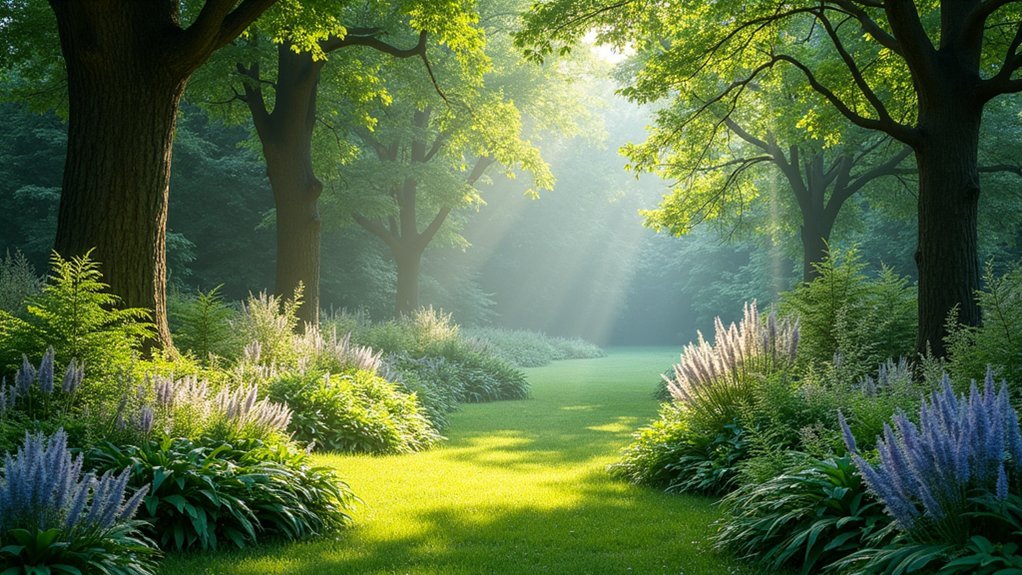



Leave a Reply